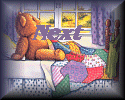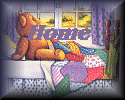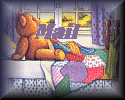WHAT
YOUíLL
NEED:
Tools:
_
Drill,
with
bits
for
both
wood
and
metal
_
soldering
iron
for
wiring
connections
_
hand
saw
_
sandpaper
or
an
electric
sander
_
a
lot
of
patience!
Hardware:
_
chair
(more
on
chair
later)
_
plywood
board
:
length,
width
and
thickness
will
depend
upon
size/weight
of
chair
and
child
_
1
front
wheel
:
pivoting
wheel
_
2
back
wheels
(we
are
using
clear
plastic
skateboard
wheels
after
having
a
bad
experience
with
black
nylon
wheels
tracking
up
the
tile
floor)
more
on
wheels
later
_
2
electric
motors
(more
on
motorization
later)
_
joystick
_
plastic
and
metal
boxes
_
metal
bar
to
mount
joystick
box
_
screws
and
bolts
THE
CONCEPT:
I
wanted
to
make
Maxís
car
as
simple
as
possible,
to
use
a
minimum
number
of
tools
and
off-the-shelf
hardware.
For
example,
I
used
electric
screwdrivers
for
propulsion
instead
of
motors.
If
you
have
ideas
to
make
it
better,
go
for
it,
and
let
us
know
of
your
adaptations!
I
wonít
give
you
size
details
because
in
the
US
you
have
different
size
standards
for
hardware.
The
Maxou
Mobile
moves
forward,
backward,
turns
left
and
right.
It
cannot
move
diagonally
and
has
only
one
speed.
THE
SEAT:
We
already
had
a
special
orthotic
seat
for
him
:
thatís
the
one
we
used,
but
if
you
donít
have
one,
you
can
use
a
car
seat
or
some
other
type
of
seating,
but
the
child
must
be
belted
in.
The
stop
and
go
is
pretty
powerful,
so
the
seatbelt
is
a
must.
You
may
also
want
to
make
the
seat
incline
a
little
to
the
rear
(using
a
wooden
wedge
or
something
else,
once
we
used
a
dishcloth)
so
the
stop
and
go
isnít
too
abrupt
for
his
neck
and
head
control.
THE
CHASSIS:
I
used
a
plywood
board
about
half
an
inch
thick
(17mm).
I
donít
want
to
get
too
much
into
size
details:
use
a
board
thatís
thick
and
strong
enough
to
support
the
weight
of
the
seat,
the
child
and
the
hardware
drilled
into
it,
otherwise
the
board
will
bend
and
the
motors
will
touch
the
ground.
The
size
of
the
board
will
also
depend
on
the
seating
you
use.
Consider
the
amount
of
space
needed
at
the
end
of
the
board
for
the
childís
feet.
THE
WHEELS:
The
wheels
are
installed
in
a
triangular
shape.
For
the
front
wheel
(and
only
the
front
wheel!),
I
used
a
pivoting
wheel
normally
used
for
furniture.
The
wheel
I
used
does
not
have
a
ball
bearing
but
the
support
does.
Make
sure
the
pivoting
wheel
can
rotate
easily
under
the
seat/child
load.
The
diameter
of
the
back
wheels
you
choose
is
important
because
it
will
determine
the
torque
and
speed:
the
smaller
the
wheel,
the
better.
You
donít
want
your
kid
to
fly!
For
the
2
back
wheels
I
first
used
narrow
plastic
wheels.
I
drilled
the
center
to
fit
the
screwdriver
(motor)
axle
diameter.
I
adjusted
the
final
diameter
with
a
round
file,
then
pushed
hard
to
fit
the
wheel
on
the
axle.
It
worked
but
the
wheels
I
chose
were
made
of
nylon
(avoid
those)
and
slid
on
the
ground.
So
I
switched
to
clear
plastic
skateboard
wheels.
The
problem
I
had
with
skateboard
wheels
is
that
they
are
hollow.
So
I
bought
melting
plastic
:
pour
the
plastic
in
boiling
water
and
when
melted,
pour
the
melted
plastic
in
the
wheel.
Once
the
plastic
has
cooled
off,
drill
into
the
center.
skateboard wheels and bag of plastic beads for melting
THE
MOTORS:
You
can
use
anything
to
make
the
motors
(avoid
300hp
V8
thoughÖ)
but
to
make
it
easy,
I
used
2
Black
and
Decker
battery-operated
cordless
electric
screwdrivers.
Axle
size
:
the
longer
the
better,
with
a
minimum
of
one
inch!
Use
an
axle
with
at
least
the
same
width
of
the
wheels
you
will
use.
Speed
:
should
be
about
150-200
rpm
Torque
:
select
a
2.4V
or
even
better
:
a
3.6V
Total
body
diameter
should
be
as
narrow
as
possible
--
about
2
inches
Shape
:
round
is
better
to
be
attached.
-
Must
have
screw
/
unscrew
capability
with
a
switch.
-
if
possible
with
a
torque
limiter
(so
when
the
car
runs
up
against
the
wall,
the
screwdriver
will
skid
but
the
wheel
wonít
turn.
You
can
see
on
the
picture
numbers
2,
3
that
the
ring
adjusts
the
maximum
torque.
I
used
pipe
holder
to
bolt
on
the
screw
driver
on
the
board.
Screwdriver
fixation:
Motors
electric
wiring:
I
nailed
a
domino
to
the
board
for
easy
wiring.
I
cut
the
screwdrivers
with
a
metal
saw
between
the
electric
motors
and
the
batteries.
I
took
off
the
battery
of
each
screwdriver
and
soldered
an
electric
wire
directly
onto
the
electric
motor.
THE
JOYSTICK:
I
bought
a
small
joystick
from
an
online
electronics
store
but
you
could
use
an
old
one
(Apple
computer
or
something
equivalent).
Just
make
sure
itís
not
too
hard
to
manipulate
for
your
kid.
I
had
to
cut
a
spring
in
half
inside
to
make
it
easier.
I bought an aluminum box (for electronic circuits) to make the armrest and installed the joystick.
You
can
also
buy
end
caps
for
this
box
instead
of
using
electrical
tape.
The joystick is fitted from underneath and I covered the hole with electrical tape.
THE
ELECTRICAL
WIRING:
The
goal
is
to
control
the
direction
of
rotation
of
the
wheels
:
Left
wheel Right
Wheel Car
direction
Direction
of
rotation
of
wheels
Forward Forward Forward
Direction
of
rotation
of
wheels Backward Backward Backward
Direction
of
rotation
of
wheels Backward Forward Left
Direction
of
rotation
of
wheels Forward Backward Right
To
do
that
you
must
control
the
on/off
and
polarity
of
each
motor
(+/-
or
-/+).
THE
CHARGER:
I
discarded
the
original
charger
base
(on
the
left
in
picture)
and
connected
a
standard
audio
jack
on
the
charger.
Itís
easy
to
plug
in
the
charger
and
recharge
the
batteries
whenever
they
run
down.
We
are
looking
into
getting
a
longer-lasting
battery,
as
the
one
we
have
lasts
about
half
an
hour.
I
attached
the
armrest
with
a
metal
bar
:



